The Beauty of Reclaimed Wood Bathroom Vanities
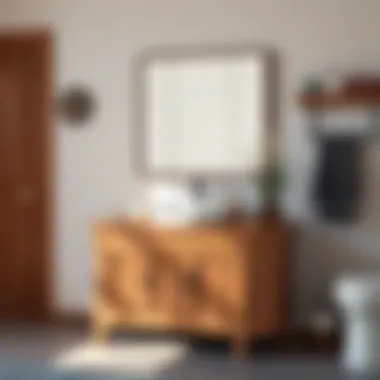
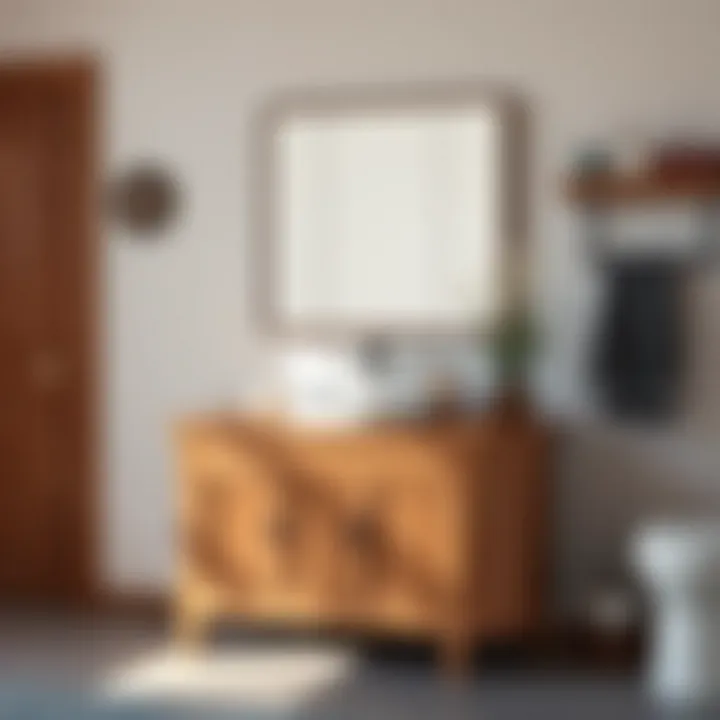
Intro
When it comes to designing a bathroom that speaks to both style and sustainability, reclaimed wood bathroom vanities are like the cherry on top of a beautifully crafted cake. Not only do these pieces offer a rustic charm, but they also come with a backstory, adding character and authenticity to any space.
Reclaimed wood, sourced from old barns, furniture, and other structures, isn’t just eco-friendly; it’s also unique. Each vanity tells a story through its grain and finish, making it a perfect fit for homeowners looking to infuse their bathrooms with a touch of individuality. With a wave of eco-consciousness washing over many of us today, opting for reclaimed materials can also be a nod to sustainability, reducing wood waste and the carbon footprint associated with new production.
This article unpacks everything there is to know about selecting and installing bathroom vanities made from reclaimed wood, right from gathering materials to enjoying that freshly revamped space. First things first, let’s dive into the Materials you will need.
Materials:
Creating your own reclaimed wood bathroom vanity can be a satisfying yet straightforward project. Here’s what you will need:
- Reclaimed Wood (varying lengths for the top and base): 1 x 2 x 8 ft board for the base, and a 1 x 4 x 5 ft for the countertop.
- Plywood for the vanity sides: 3/4" thick, 4 x 8 ft sheet.
- Wood Glue: a strong, waterproof variety will hold everything together.
- Wood Screws: 1.5 inches long, stainless steel.
- Varnish or Wood Stain: depending on your desired finish, choose a non-toxic formula suitable for bathrooms.
- Sink: in-set, vessel, or under-mount, your choice will affect dimensions.
- Faucets: appropriate for your sink selection.
- Drawer Slides: soft-close slides are preferable for modern usability.
- Cabinet Handles: these can range from modern to rustic designs.
- Brackets: for any needed extra support when mounting.
Other Items:
- Sandpaper: 80 and 220 grit
- Paintbrushes or rollers for stain or varnish
- Clean rags for applying finishes
- Measuring tape
- Level
DIY Steps:
Once you’ve gathered your materials, follow these steps to create a stunning reclaimed wood vanity.
Step 1: Measurement and Cutting
Begin by measuring your bathroom space and determining the size of the vanity. Using your plywood, cut two side panels, a top, and a bottom panel. The usual width is around 24 inches for the base, but tailor it to fit your needs.
Step 2: Assemble the Frame
Using wood screws and glue, assemble the sides to the bottom and top panels. Make sure everything is square (use your level to double-check). Fix any brackets for support if your design requires.
Step 3: Attach the Countertop
Carefully place and attach the reclaimed wood countertop on top of the frame. Secure with screws from the underside, taking care not to show any fixings.
Step 4: Finish the Surface
Sand down the surfaces using the 80 grit sandpaper and finish off with the 220 grit for a smooth touch. Apply your chosen stain or varnish and let it dry completely as per instructions.
Step 5: Install the Sink and Fixtures
Once the finish is dry, cut the necessary openings for your sink and install it according to the manufacturer's instructions. Attach the faucet onto the sink as needed.
Step 6: Drawer and Handle Installation
Finally, attach your drawer slides into the frame followed by any drawers you’ve created. Don’t forget those handles; they can really tie the whole look together!
Technical Aspects:
A successful DIY project requires some handy tools and knowledge:
- Tools Needed:
- Timing: Creating a reclaimed wood vanity could take anywhere from one weekend for more experienced DIYers to several weekends for novices, especially if allowances are made for drying times of finishes.
- Critical Techniques:
- Circular saw or table saw for cutting wood
- Drill/driver for installing screws
- Sander for smoothing surfaces
- Measuring tape and square for accuracy
- When sanding, always move along the wood grain to avoid visible scratches.
- Pre-drill holes for screws to avoid splitting the wood.
"A reclaimed wood bathroom vanity not only enhances aesthetics but also showcases a profound love for nature and sustainability."
DIY Project Process:
Now that you’ve assembled everything perfectly, it’s time for installation. The process can vary based on existing plumbing and layout.
Installation Steps:
- Place the assembled vanity into position, ensuring it’s level.
- Secure the vanity to the wall if desired for safety, especially if it’s a tall cabinet.
- Connect your plumbing to the sink and ensure leaks are promptly checked.
Troubleshooting Tips:
- If the drawers don’t slide well, check that the slides are installed correctly and the drawers aren’t overfilled.
- For any gaps where the sink meets the vanity, use caulk to create a water-tight seal.
With these steps, you’re not just adding a fixture, but a piece of art that speaks to your values. Dive in and create something truly unique with reclaimed wood.
Understanding Reclaimed Wood
Reclaimed wood has become quite the topic in home design, and there’s good reason. In the world of bathroom vanities, using reclaimed materials brings not just environmental benefits, but also a unique charm and character. As homeowners look to create spaces that express their individuality and align with sustainable practices, understanding what reclaimed wood is and how it fits into design becomes essential.
Definition and Origin
Reclaimed wood refers to timber that has been salvaged from old structures, such as barns, factories, or warehouses, rather than being freshly cut from trees. This practice of reusing lumber has gained traction as eco-consciousness rises. Instead of letting wood go to waste, artisans breathe new life into it, transforming aged wood into stunning, functional pieces for your bathroom. It’s like giving a second chance to something that has history.


Historical Context
The use of reclaimed wood is not just a modern trend; it carries historical significance. Structures made from heavy, old-growth timber stood against the test of time, often dating back to the 19th or even 18th centuries. When these buildings are deconstructed, the wood holds stories. Each piece of reclaimed wood has its own unique aging process, showing wear that adds texture and depth. It’s a reminder of craftsmanship from a bygone era that resonates with many homeowners today.
Types of Reclaimed Wood
When it comes to bathroom vanities, not all reclaimed wood is created equal. Each type offers its own distinct features that can enhance the overall aesthetic.
Barn Wood
Barn wood is particularly sought after due to its rustic appeal. It's derived from old barns and often showcases weathered charm, complete with knots and nail holes that tell a story. This wood brings warmth to any room and pairs beautifully with modern or eclectic designs. However, it might require some refinishing to suit your style better, since it can be rough around the edges. Despite this, many homeowners see its potential, appreciating its character and the sustainable aspect.
Scrap Wood
Scrap wood is any leftover timber from various construction projects. It can come from different sources, leading to a mix of textures and colors that create a unique look. This type of wood is often budget-friendly, making it a popular choice for those looking to be eco-conscious without breaking the bank. Its versatility allows it to fit into various design styles, although the inconsistency might not appeal to everyone.
Old Growth Timber
Old growth timber is lumber sourced from trees that have been around for centuries. This kind of wood is highly prized due to its density and durability. The pattern found in old growth timber is often unique and stunning. While it’s a premium option, its longevity and beauty make it a worthwhile investment. However, sourcing this type of wood could be challenging and may raise sustainability concerns, as the demand for it must be balanced with responsible logging practices.
"Reclaimed wood is not just a material; it's a piece of the past, beautifully intertwined with the fabric of modern design."
Overall, understanding the origins, history, and types of reclaimed wood is the first step toward making informed choices in your bathroom vanity selection. Each type tells a story and brings a distinct character, making your bathroom not just a functional space, but a statement of your values and style.
The Appeal of Bathroom Vanities
Bathroom vanities made from reclaimed wood are not just functional furniture pieces; they embody a lifestyle choice that emphasizes both aesthetics and sustainability. Choosing such vanities can transform a mundane bathroom into a distinctive haven, merging old-world charm with modern design. The essence of reclaimed wood lies in its story; it brings historical depth and character that new materials simply cannot replicate.
Aesthetic Versatility
The versatility of bathroom vanities crafted from reclaimed wood makes them an appealing choice for various design preferences. These vanities seamlessly blend into diverse decor styles, whether you're leaning towards sleek modernity, cozy rustic vibes, or a mix that defies conventions. They serve not just as storage solutions but as conversation starters, enriching the overall visual narrative of the space.
Modern Designs
Modern designs of reclaimed wood vanities present a sleek, minimalist appeal that often incorporates clean lines and polished finishes. This aspect signals a shift towards a more sustainable future while not compromising on style. The key characteristic here is the emphasis on the wood's natural grain, which can be accentuated with finishes that enhance its beauty yet keep the design simple. These vanities are particularly prized because they offer an opportunity to showcase craftsmanship while blending seamlessly into contemporary bathroom aesthetics.
The unique feature of modern reclaimed wood designs lies in their ability to combine industrial elements, like stainless steel fixtures, with warmth from the wood. This combination can lead to a balanced atmosphere, making the bathroom feel both inviting and chic. However, the minor downside is that maintaining that fresh modern look can require more frequent cleaning due to the sheen of the finish.
Rustic Accents
Rustic accents in bathroom vanities created from reclaimed wood invite a sense of warmth and nostalgia that appeals to many homeowners. The inherent irregularities in reclaimed wood, such as knots and weathered textures, serve as reminders of the material's past, giving each piece a unique character. The unrefined aspects of rustic designs create a homey feel that is especially inviting in a bathroom, often complemented by earthy color palettes.
The key to rustic aesthetics is highlighting the natural imperfections of the wood, which speak volumes about its journey. This can evoke an emotional response, adding charm to what is often seen as a utilitarian space. One unique advantage of rustic designs is their ability to blend well with various decorative elements, such as vintage mirrors and antique light fixtures. Yet, one must consider that the rougher surface can attract dust and require a bit more effort in terms of upkeep.
Eclectic Styles
Eclectic styles offer a bold and personalized spin on bathroom vanities using reclaimed wood. The essence of this approach lies in the free-spirited nature of combining different materials, colors, and textures. Homeowners gravitating towards eclectic designs often relish the opportunity to mix and match elements, drawing from various eras and styles.
The key characteristic of eclectic styles is the unpredictability that enhances visual interest. They often incorporate bright colors and unexpected combinations, creating a whimsical yet cohesive look. In the realm of bathroom vanities, this variety can mean pairing a reclaimed wood base with colorful ceramic sinks or ornate mirrors, allowing for a playful exploration of aesthetics.
One notable feature of this style is its potential to tell a story—each choice reflects the personal history and style of the homeowner. However, the challenge here could lie in achieving balance, as too many contrasting elements might overwhelm the space if not curated thoughtfully.
Creating a Unique Space
Choosing reclaimed wood vanities allows you to curate a space that speaks to your personal style while embracing sustainable choices. These vanities not only serve practical purposes but offer a canvas for creativity in bathroom design. Transforming your bathroom into a unique retreat is achievable by considering how you can mix different styles and features into one personalized space that resonates with you.
Sustainability Considerations
Sustainability is a cornerstone when it comes to choosing bathroom vanities made from reclaimed wood. It’s not just about aesthetics or craftsmanship; it’s about making choices that positively impact the environment. These vanities reflect a commitment to ethical sourcing, conservation, and support for local economies. Let’s dive deeper into these aspects.
Environmental Impact
Reduce Carbon Footprint
One of the standout benefits of opting for reclaimed wood vanities is the potential to significantly reduce your carbon footprint. When one considers that traditional lumber production involves harvesting trees, transporting the wood, and processing it, the energy and emissions incurred are substantial. In contrast, reclaimed wood utilizes materials that have already been processed and are simply being repurposed. This one change makes a noticeable dent in greenhouse gas emissions.
The key characteristic of reducing carbon emissions in this context is the efficient use of resources that already exist. By incorporating reclaimed materials, homeowners not only lessen the impact on forests, but also minimize the energy wasted in processing new wood. This choice becomes not just a sustainable option but a popular one among environmentally conscious consumers.
There’s a unique feature here too: reclaimed wood often comes with a history, adding depth to your home’s narrative. Imagine telling guests about your vanity that once formed part of a barn. Such stories highlight the advantages of reduced environmental impact while encouraging others to consider similar paths for their renovations.
Conserve Resources
Conserving resources is another critical aspect of opting for reclaimed wood. Each slab of reclaimed wood represents a saved tree, a conserving act itself. The process of reclaiming wood means fewer new trees felled, which is imperative for preserving biodiversity and promoting healthy ecosystems.
The significant feature here is the associated environmental benefits. Reclaimed wood not only allows builders and homeowners to create beautiful pieces but also plays a part in the larger goal of resource conservation. It’s a simple yet effective method to promote sustainability. Homeowners can feel good knowing their choice aligns with resource-saving values.
However, there can be downsides if not sourced properly. Sometimes, reclaimed wood can come with hidden pollutants, depending on its previous life. It’s essential to ensure that the wood is treated correctly, avoiding materials that may contain harmful chemicals. Regardless, the advantages — like fostering a sustainable future and teaching future generations about conservation — far outweigh these considerations.
Supporting Local Economies
When you purchase reclaimed wood vanity, there’s an indirect but powerful benefit at play: supporting local economies. By choosing to buy these products, one often aids local artisans and small businesses that focus on sustainability. This choice helps create jobs and fosters community ties, turning a simple home improvement project into a step towards strengthening local commerce. It’s a ripple effect that connects consumers to producers.
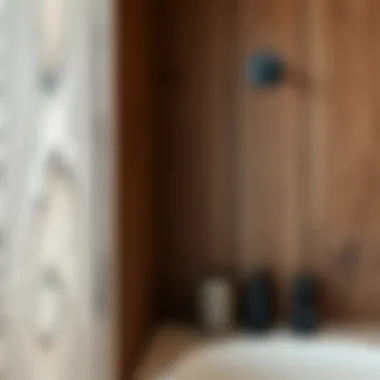
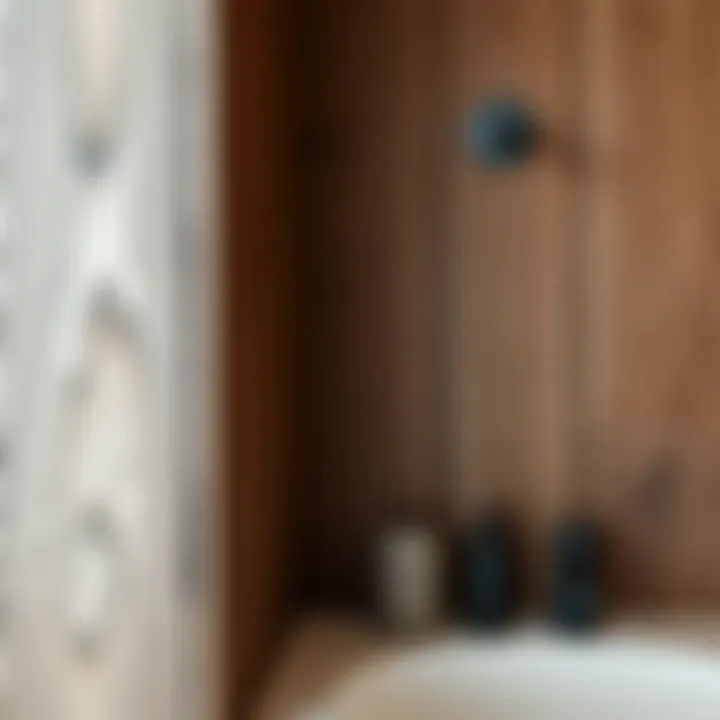
Moreover, local artisans tend to imbue their creations with care and craftsmanship that mass-produced items lack. By designing tailored, one-of-a-kind pieces, they’re not just delivering a product; they’re providing a narrative, a chance to connect deeper with both the item and those who made it.
These features create a profound impact beyond the bathroom updates, contributing to economic resilience and community building. Choosing reclaimed wood is not merely a statement for environmental respect, but a way to foster economic dependency, creating a win-win scenario for both the homeowners and the local community.
Craftsmanship in Reclaimed Wood Vanities
Craftsmanship plays a pivotal role in the allure of vanities made from reclaimed wood. The intricate details and personal touches contribute significantly to their character. Each piece tells a story, a fusion of the past and present, showcasing artistry that is often lost in mass-produced alternatives. These vanities not only serve as functional furniture but also as conversation starters, encapsulating a blend of history and functionality that truly beautifies any bathroom.
Artisan Techniques
Joinery Methods
Joinery methods are at the heart of crafting reclaimed wood vanities. This technique is not just about connecting pieces; it’s about marrying form with function. Techniques such as dovetail and mortise-and-tenon joints offer exceptional strength and durability, ensuring that the vanity can withstand the test of time. Dovetail joints, in particular, are favored for their interlocking design, which provides resistance against pulling forces, making them a popular choice among artisans.
In this context, a unique feature of joinery methods is their ability to highlight the natural beauty of the wood. The visible joints showcase the craftsmanship involved, adding depth and interest to the piece. However, these methods require skill and patience, and the craftsmanship behind them sometimes comes with a higher price tag. But the enhanced durability and stunning aesthetic often justify the investment, providing long-term value to homeowners.
Finishing Techniques
Finishing techniques also hold significant importance in the creation of reclaimed wood vanities. Proper finishing not only protects the wood but also enhances its natural luster and character. Techniques like oil finishes or water-based lacquers are popular choices for their ability to bring out the wood’s grain and colors while providing essential protection against moisture—a critical consideration in bathroom environments.
What differentiates these finishing techniques is the level of customization they offer. Homeowners can choose finishes that complement their decor, ensuring that every vanity is as unique as the space it occupies. However, some finishes may have environmental impacts; for instance, oil finishes may require more frequent reaplication compared to synthetic options. Therefore, striking a balance between aesthetics and practicality is essential.
Quality Over Quantity
When it comes to craftsmanship, the mantra of "quality over quantity" resonates deeply. Reclaimed wood vanities, often crafted in smaller batches, exemplify this idea. Each piece involves careful selection of wood, meticulous attention to joinery, and thoughtful finishing, which altogether ensures a superior end product. This contrasts sharply with the fast-paced production of generic furniture, where quantity can sometimes overshadow individual quality.
Opting for a high-quality reclaimed wood vanity is not just a matter of aesthetics; it’s an investment in sustainability and durability. The end result is a beautiful, functional piece that aligns with eco-conscious living, proving to be a valuable addition to any bathroom.
Practical Considerations
When diving into the world of bathroom vanities made from reclaimed wood, practical considerations are crucial. These factors not only help you maintain the beauty and integrity of your vanity but also ensure it serves you well for years to come. Homeowners should make informed decisions that echo the investment’s quality, sustainability, and usability.
Maintenance and Care
Cleaning Techniques
Maintaining a reclaimed wood vanity doesn't have to be rocket science. The primary aspect is regular cleaning to keep it looking fresh and new. Using a soft cloth or microfiber towel can work wonders in removing dust and debris. Avoid harsh chemicals, as these can strip the natural oils from the finish and wear down the wood over time.
A gentle mix of warm water with a few drops of biodegradable soap is often viewed as a top choice. This technique respects the material while ensuring it stays clean. Some cleaners specifically designed for wood surfaces can also be beneficial. They often have unique features like plant-based ingredients which preserve the environment as well.
However, a word of caution must be highlighted here. Over-wetting the wood can lead to warping. So, it is wise to make sure your cloth is damp, not soaking wet. This approach keeps the wood's finish intact while promoting longevity.
Preventing Damage
Preventing damage to your reclaimed wood vanity encompasses several practices. The main goal here is to shield the wood from moisture and physical harm. For instance, placing coasters under toiletries can prevent stains and marks. It’s a simple step but incredibly effective.
Another key characteristic in the fight against damage is controlling humidity levels in the bathroom. Keeping the area well-ventilated reduces the risk of wood swelling or splitting, which can be significant issues with reclaimed materials. Incorporating a dehumidifier or simply cracking open a window can work wonders.
Despite these practices being widely praised for their effectiveness, some owners may overlook them due to a busy lifestyle. However, neglect can lead to costly repairs in the long run, making proactive measures more than worth the effort.
Cost Factors
Initial Investment
When it comes to acquiring a reclaimed wood vanity, the initial investment must be scrutinized. Reclaimed wood tends to come at a price higher than conventional materials, but this typically reflects quality and history. The uniqueness of each piece, coupled with the craftsmanship involved in its creation, justifies the cost.
Investing in this type of vanity also means you’re opting for sustainability, which has become a trend embraced by many consumers. Supporting ethical sourcing and reducing demand for new wood contributes positively to the environment.
Moreover, these vanities often come with their stories, making them captivating additions to your home. A unique grain pattern or a knot from a former life adds character. This can make the slightly higher price point feel even more worthwhile.
On the flip side, there's the potential for future repairs or refinishing, which are considerations that can push the overall cost higher. Balancing these aspects helps homeowners gauge their willingness and ability to invest long-term.
Long-term Value
When assessing long-term value, reclaimed wood vanities stand out as solid investments. Unlike their synthetic counterparts, these vanities can improve with age, developing a rich patina that enhances their charm. Over time, you may find the wood becoming more visually appealing, which could even increase the home's value.
Additionally, the inherent durability of reclaimed wood can hold its own against wear and tear. When cared for properly, you might be surprised at how long these pieces last. The ability to refinish or repair them when needed further adds to their viability as a long-term option.
Ultimately, choosing a reclaimed wood vanity isn’t merely a purchase; it’s a commitment to sustaining both functionality and aesthetics. It reflects a deeper sense of environmental responsibility while simultaneously adding a unique flair to your bathrooom.
"Investing in reclaimed wood isn’t just about aesthetics; it’s about choosing a lifestyle and supporting sustainable practices that benefit both you and the planet."
Comparative Analysis
In the realm of bathroom design, conducting a comparative analysis is invaluable. This section shines a light on how bathroom vanities made from reclaimed wood stack up against their newer counterparts and synthetic materials. By examining aesthetic and sustainability factors, homeowners can make well-informed choices that resonate with both their personal style and ethical values.
Reclaimed Wood vs. New Wood
Aesthetic Differences
When it comes to aesthetics, reclaimed wood brings with it a certain character that new wood simply cannot replicate. The richness and depth of reclaimed wood often bear marks of its history—knots, scars, and unique grain patterns. Each piece tells a story, creating a warm and inviting atmosphere. Homeowners often find that these distinctive features resonate with their desire for a unique space, setting their bathroom apart from the cookie-cutter styles of typical home improvement stores.
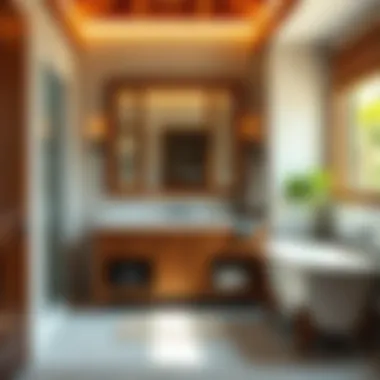
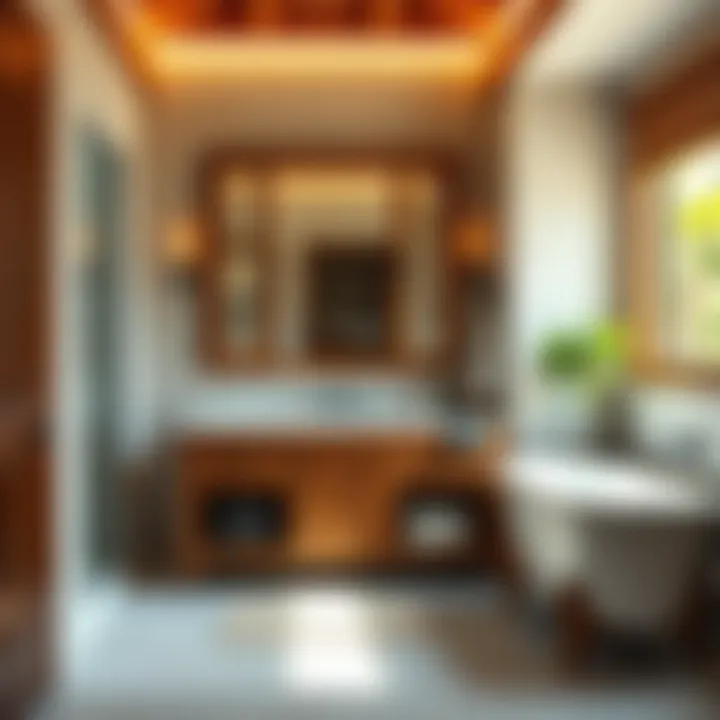
On the flip side, new wood offers a pristine and uniform appeal that can fit seamlessly into more modern or minimalist designs. However, many find this predictably bland compared to the individuality that reclaimed wood brings.
Here’s a quick rundown of some key aesthetic factors:
- Reclaimed Wood: Unique character, warmth, historical depth.
- New Wood: Uniformity, simplicity, modern appeal.
While new wood can be visually appealing in a clean-cut way, reclaimed wood's charm often emerges as a favored choice for those wanting both beauty and a touch of nostalgia in their space.
Sustainability Metrics
Sustainability is a core consideration for many homeowners today. Reclaimed wood vanities are not just a nod to aesthetics but also play a pivotal role in reducing waste. By sourcing wood that would otherwise contribute to landfills, reclaimed wood vanities stand out in their eco-friendly offerings. Not to mention, the energy expenditure required to manufacture new vanities is generally higher than that required for reclaimed options.
A couple of significant points about sustainability are worth considering:
- Carbon Footprint Reduction: Using reclaimed materials lowers the overall environmental impact.
- Resource Conservation: Reclaimed wood sidesteps the deforestation involved in new wood production.
In contrast, new wood, while sourced responsibly at times, often comes from trees specifically harvested for industry use. Thus, it rarely achieves the same level of sustainability as reclaimed options.
Reclaimed Wood Options vs. Synthetic Materials
Durability
Durability may initially seem to favor synthetic materials, which are often designed for longevity. However, when examined closely, reclaimed wood can prove equally robust if not superior in many cases. This wood typically comes from older trees, which often means denser and stronger material due to years of growth.
Here are several factors to weigh:
- Reclaimed Wood: Can be surprisingly resilient, especially older growth timber. With proper care, reclaimed vanities can last generations.
- Synthetic Materials: Usually designed to resist scratches and damage, but might lack the warmth and charm of natural wood.
Both options have their strengths, but many homeowners find that the enduring beauty and functionality of reclaimed wood often wins out in the long run.
Environmental Impact
The environmental impact of reclaimed wood materials surfaces again when stacked against synthetic variants. Synthetic materials often rely on petrochemicals for production, which can pose issues like pollution and resource depletion. In contrast, reclaimed wood provides a more sustainable avenue with minimal new resource usage.
Here's why considering environmental impact can be crucial:
- Less Waste: Keeps usable materials out of landfills and contributes to a circular economy.
- Lower Pollution: Limited emissions from production processes, compared to synthetics.
While synthetic options may offer some immediate advantages, the long-term ecological implications make reclaimed wood a frontrunner for conscientious homeowners.
"When you choose reclaimed wood, you’re not just choosing a piece of furniture, but a story, a history, and a commitment to sustainability."
In summary, reclaimed wood vanities stand out for their unique aesthetics, robust sustainability, and long-term durability when compared against new wood and synthetic materials. Understanding these factors can help homeowners create not just a beautiful bathroom but a more responsible one as well.
Design Inspirations and Trends
In the realm of bathroom design, the incorporation of reclaimed wood vanities has kindled a wave of creativity and uniqueness. These vanities not only reflect personal style but also tell a story of history and sustainability. As homeowners embrace eco-friendly choices, understanding design inspirations and the prevailing trends becomes crucial to making the right decisions that align with both aesthetics and values.
Vanities made from reclaimed wood offer a myriad of design possibilities. They can blend harmoniously with both modern and traditional spaces. The key lies in recognizing how color, texture, and form can interplay to create a stunning focal point in the bathroom.
Color Palettes
Color plays a pivotal role in setting the mood and atmosphere of any space. For reclaimed wood vanities, it’s not just about the wood's natural hues but also how these can be paired with complementary tones in the bathroom. The rich, earthy shades of reclaimed wood can bring warmth and depth, grounding the space and making it feel inviting.
Here are a few distinctive color palettes to consider:
- Neutral Earth Tones: Shades like taupe, beige, and soft gray can unify the wood’s organic appearance, promoting a calm ambiance.
- Bold Contrasts: Pairing dark woods with bright whites or vibrant colors creates a striking visual balance that commands attention.
- Muted Pastels: Soft greens, blues, or pinks can lighten the overall look, making the reclaimed wood stand out as a center of interest without overwhelming the space.
- Monochromatic Schemes: Sticking to varied shades of one color fosters a clean, cohesive look. For instance, different shades of blue can create a serene nautical feel, while maintaining focus on the wood’s textures.
The finish of the wood plays an equally essential role in the color scheme. Matte finishes can create a rustic and raw look, while gloss finishes tend to enhance color richness, adding a hint of sophistication.
Integration with Bathroom Fixtures
When it comes to renovating a bathroom, seamless integration of the vanity with existing fixtures is crucial. This ensures a coherent aesthetic and functionality. Reclaimed wood vanities can complement various styles of faucets, sinks, and shower fixtures, catering to modern and classic tastes alike.
- Types of Fixtures to Consider:
- Stylish Faucets: Choose fixtures that harmonize with the wood’s vibe. Vintage-inspired faucets can enhance rustic charm, while sleek, stainless steel options suit modern themes.
- Sinks: Vessel sinks, particularly those crafted from ceramic or stone, often make for an excellent pairing with reclaimed wood vanities. The juxtaposition of materials provides a nice visual contrast.
- Lighting: Hanging pendant lights or sconces can accentuate the beauty of reclaimed wood. Opt for fixtures that either meld with the wood’s finish or stand out as a bold statement piece.
Extracting the most from a reclaimed vanity isn’t just about picking the right wood. It’s about how all these elements come together in your bathroom. The design choices extend beyond vanity placement or material selection. They reflect personal tastes and values that resonate with the homeowner's aspiration of blending sustainability with sophistication.
"Choosing reclaimed wood vanities isn’t just about style; it's about contributing to a sustainable future while enhancing your home’s beauty."
Through thoughtful design inspirations and trends, reclaimed wood bathroom vanities become significant players in transforming spaces into inviting havens.
The End: The Future of Bathroom Design
As we move forward into a new era of design, the emphasis on individuality and sustainability is becoming increasingly palpable. The role of reclaimed wood in bathroom vanities serves as a testament to this shift, combining beauty, character, and a conscious choice for the environment. The importance of these vanities goes beyond their physical presence in a home; they weave a narrative into the very fabric of bathroom design, helping us express values that matter in today’s society.
The Role of Reclaimed Materials
When we talk about reclaimed materials, we essentially refer to something much more than just reused wood. Each piece has a story, with its unique marks, textures, and colors arising from its previous life. This not only gives character to the vanity but also fosters an emotional connection between homeowners and their spaces.
- Aesthetics: The variety of reclaimed wood allows for endless design possibilities. For instance, barn wood can bring warmth and rustic charm to a bathroom, while reclaimed oak can add a sense of elegance. The natural grain and imperfections offer a timeless beauty that mass-produced options often lack.
- Sustainability: Choosing reclaimed wood enhances environmental consciousness. This practice helps reduce waste and minimizes the demand for new timber, preserving forests for future generations. It aligns with a growing trend toward eco-friendly habits, making a statement that resonates with increasingly aware consumers.
- Versatility: Reclaimed wood can seamlessly fit into both modern and traditional designs. The flexibility in style enables homeowners to experiment with various finishing techniques, from rough and unpolished to sleek and polished, thus creating a customized visual experience.
- Durability: Many reclaimed woods, having withstood the test of time, carry a reputation for strength and longevity. For example, old growth timber is often denser and tougher than contemporary counterparts, offering a sturdiness that appeals to anyone looking for lasting quality.
“One person's trash is another person's treasure” rings especially true in the world of reclaimed wood. The past lives of these materials add depth to the present, bringing historic value into a space that often serves as a private retreat away from the hustle.
As we conclude this exploration into bathroom design, it becomes clear that reclaimed wood vanities are not just a fleeting trend; they represent a profound connection between people and the planet. Embracing these elements signifies a shift in how we consider our homes and their impact on the world around us. By integrating reclaimed materials, we are not merely designing spaces; we are fostering a more sustainable future, one beautiful vanity at a time.







